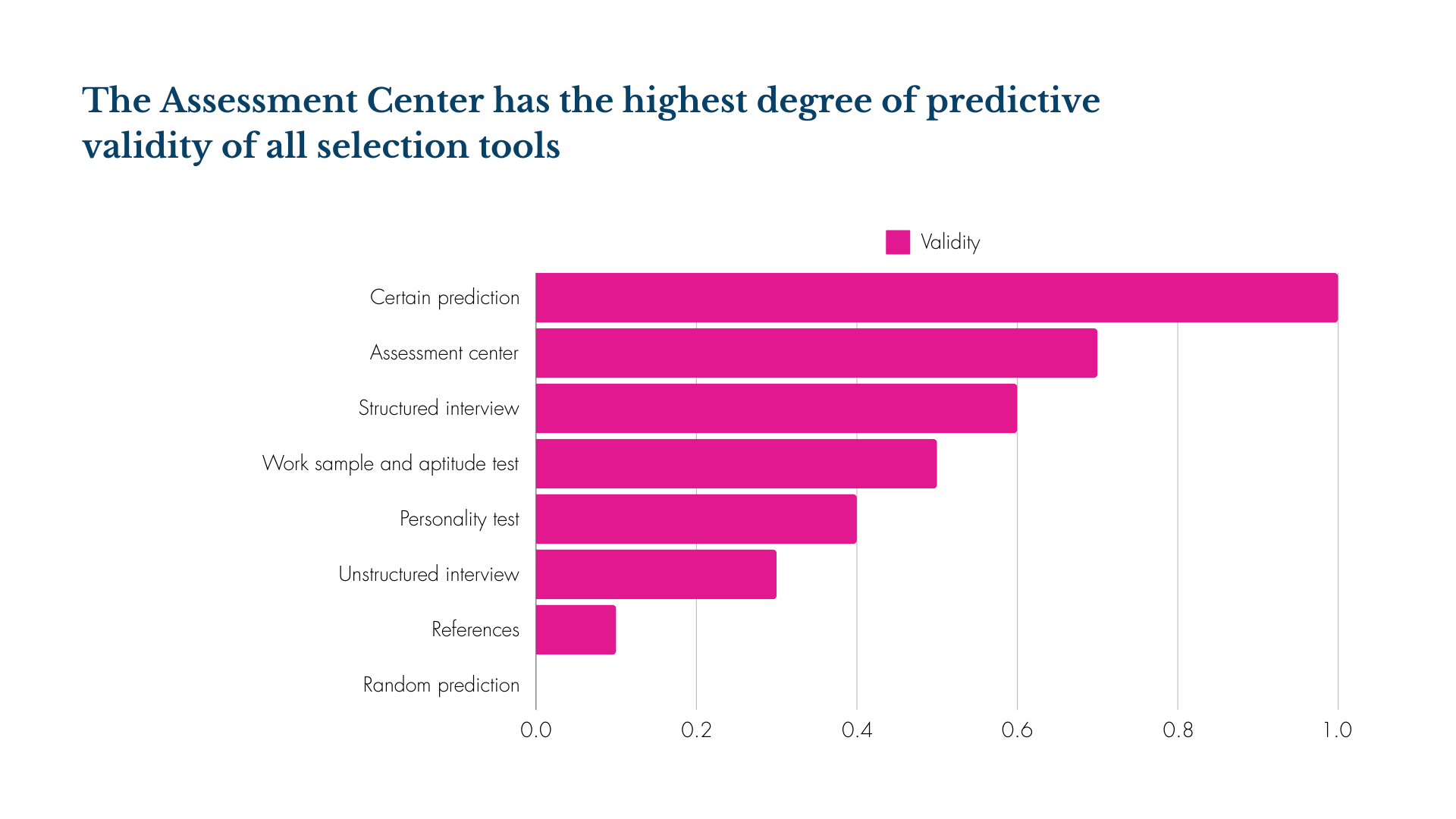Assessment Centres: comprehensive, predictive assessment for talent selection
In recent years, we have seen both continuity and evolution in the application of Assessment Centres. Faced with increasing economic pressure and the emergence of the Knowledge Economy, Talent Management has become an increasingly essential function within organisations.
Assessment Centres are now used for a wider range of purposes than ever before, and technological advances in assessment and development are enriching the method in innovative ways. However, at its core, the Assessment Center method has remained remarkably stable since its first applications, with similar dimension labels, consistent exercise types, and assessors trained to collect, synthesise and score the rich behavioural data generated during an Assessment Center programme.
How effective are Assessment Centres compared with other selection tools?
At the core of the evaluation of selection tools lies criterion validity, which measures the ability of a tool to predict relevant job outcomes, such as job performance or training success. This type of validity is also referred to as predictive validity, as it aims to anticipate a candidate's future performance based on the results obtained from the selection tool.
However, validity extends beyond criterion validity. Other types of validity must also be considered, such as construct validity and content validity, which provide deeper insights into the effectiveness of the tool.
1. Construct Validity: This examines whether the selection tool truly measures what it is intended to measure. For instance, a personality test designed to assess extraversion may not only evaluate that trait but also other aspects such as sociability or self-assertion. A common critique of certain selection methods, like role-playing exercises, is that they assess acting skills rather than actual competencies, which can lead to misleading results if the tool is not properly designed.
2. Content Validity: Content validity ensures that the tool assesses all relevant dimensions of a specific competency. For example, a role-playing exercise designed to evaluate "customer service" should measure a range of related skills, such as the ability to ask questions, empathy, and addressing the needs of different customer groups. If the tool focuses only on empathy, its validity may be questioned, as it does not cover all the targeted competencies.
The role of assessment centres in selection
Assessment Centres combine several selection tools in a structured process, often involving work samples, simulations and behavioural assessments. In terms of criterion validity, Assessment Centres are consistently rated as 'good' because of their ability to provide a comprehensive overview of candidates' skills.
Despite these challenges, the effectiveness of Assessment Centres is not in question. The tools used in Assessment Centres, particularly In-Basket, are generally designed to measure the actual skills required for the job, ensuring that candidates are assessed in a context that accurately reflects real-world scenarios.
Why do Assessment Centres have higher validity?
The old adage "recruit for attitude, train for skills" is often quoted in selection processes, but is it always practical and relevant? Let's take a look at some of the most commonly used selection tools: an audition for actors and performers, a simulator test for recruiting pilots, a presentation for a sales executive, or an office applications test for a secretary. In the case of internal applicants, many recruiters point out that, compared with external candidates, at least they know "the devil they're up against". Some companies even go so far as to ask their new recruits to recommend three people from their previous organisation. It's not uncommon for companies to target conferences to recruit their rivals' best salespeople.
But what do these apparently diverse approaches have in common? They are all based on behavioural assessment. In effective selection, our aim is to extract information about a candidate's behaviour, whether verbal (everything the person says) or visual (everything they do).

Source : Contemporary HRM in practice : Pilbeam, S. & Corbridge, M. Pearson Education Ltd. (2006)
The importance of behaviour in recruitment
In the workplace, it is behaviour that produces results when it is appropriate, or that can cause problems when it is inappropriate. Behaviour can be observed in many professional contexts. For example, we see an employee taking an interest in a customer, while at the same time hearing the customer's open-ended question. We observe a manager raising his voice at a member of his team while raising a threatening finger. As a result, these behaviours produce reactions in others: a smile, an agreement, a counter-argument or a proposal, among others.
Behaviour is something we can control, something we can adapt to situations. An individual can adopt a behaviour that will help them to achieve a positive result in a situation, or, on the contrary, an inappropriate behaviour that will not lead to any result. Herein lies the importance of observing behaviour in the selection process.
The limits of traditional selection tools
The major problem with traditional selection tools, such as the interview, is that they offer only a very limited view of how a candidate should behave in an artificial situation. During an interview, candidates are often confronted with ill-defined expectations and pressures as to how they should behave. As a result, their behaviour can vary depending on the context and their perceptions of the interview.
Some candidates may adopt a calm and low-key attitude during the interview, even if they are determined and assertive at work. Others may be over-confident, which does not necessarily reflect the way they interact with others in a professional environment. As a result, these interviews fail to capture the full range of behaviours that really influence performance at work.
The effectiveness of Assessment Centres: a global observation of behaviour
This is where Assessment Centres make a significant difference. Unlike interviews, Assessment Centres provide a more comprehensive and accurate assessment of candidates' behaviour, as they are designed to observe a much wider range of behaviours in a variety of contexts, close to those of real work. Candidates are confronted with simulations of professional situations, realistic scenarios and practical skills tests that enable them to demonstrate not only their know-how, but also the way they react when faced with challenges.
By assessing specific behaviours in situations that closely resemble professional reality, Assessment Centres offer a more accurate assessment of a candidate's potential. Recruiters can observe how each individual reacts to different stimuli, how they handle pressure and interact with colleagues or potential clients. These observations provide a more accurate picture of the candidate's behavioural skills, which are essential for predicting their performance in the role for which they are applying.
